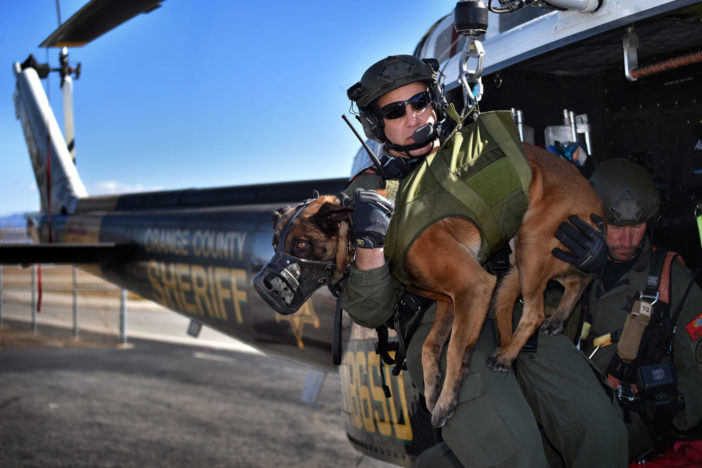Standing near the Orange County Sheriff’s Department Duke 6 helicopter, the medics stood around 5-year-old Cento, a Belgian Malinois, petting and encouraging him.
Fortunately, Cento wasn’t in need of any medical care, but he was practicing what would happen if he was.
“Everything we do for the dogs, we make it a game,” said Deputy Brian Stockbridge, part of the Aviation Support Unit, explaining how OCSD K9s train with medics that are part of the Air Rescue Tactical team — the ones who would treat the dogs if they were injured in the line of duty.
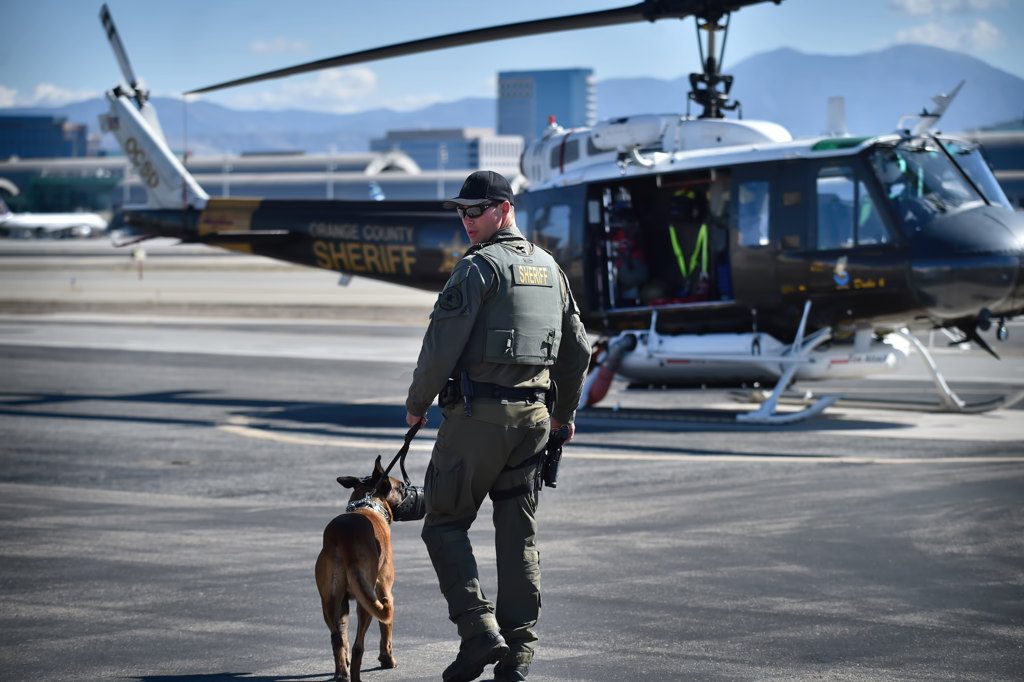
OCSD Deputy Mark Van de Kreeke walks his dog, Cento, to Duke 6, a Huey helicopter used for search and rescue, during training at John Wayne Airport.
Photo by Steven Georges/Behind the Badge OC
Of the 20 Air Rescue Medics, 12 make up the team of Air Rescue Tactical Medics, which began over two years ago at the OCSD. The team of medics are trained to treat onsite, both human and K9 law enforcement, who have been injured while on duty, said Special Enforcement Bureau Chief Medic Mike De Laby.
“A lot of it is basically the same equipment or medicine that we would use on an adult,” he said.
The team’s Medical Flight Crew bags contain all levels of life-saving supplies, tools and medicine necessary to stabilize an injured deputy or law enforcement K9.
K9s, like their handlers and other officers, are at risk of any of a number of dangers, including stabbing, assault, smoke inhalation, burns, dehydration, etc., said De Laby.
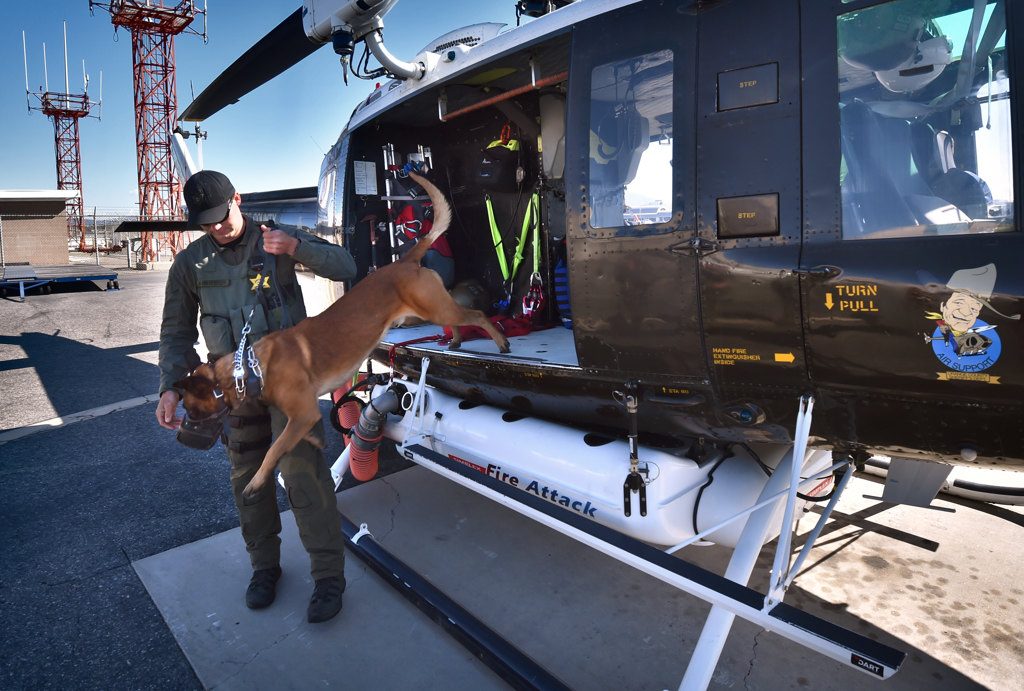
OCSD Deputy Mark Van de Kreeke has Cento, a K9 with the Orange County Sheriff Department, get used to Duke 6.
Photo by Steven Georges/Behind the Badge OC
“If a dog was having breathing difficulty … we could put a breathing tube in,” he said. “We can start IVs to give fluid and medication.”
They can work to control bleeding by applying direct pressure or a tourniquet if a K9 is stabbed or shot, he added. The medics even carry Narcan nasal spray, which counteracts the effects of an opioid overdose, since narcotics-sniffing dogs could be exposed to any of a number of powerful drugs.
“Our goal would be to stabilize life-threatening emergencies and get the K9 transported to a definitive K9 facility … the emergency vet,” he said.

OCSD Deputy Mark Van de Kreeke, left, and PSR Mike De Laby, Special Enforcement Bureau chief medic, attach a harness to OCSD K9 Cento before lifting him into a grounded helicopter.
Photo by Steven Georges/Behind the Badge OC
The medics, who also are trained in air rescue, all took additional accredited K9 tactical medical courses on top of the required tactical medical training.
Since the program began, the team hasn’t had any K9 injuries to treat, but nonetheless team members train regularly with the OCSD K9s to be prepared for any emergency – including a medical rescue in a remote location, which would require the dog to be hoisted onto a helicopter and lifted to safety. The team is sent out regularly to SWAT situations on the ground as well as situations that may require air support rescue.
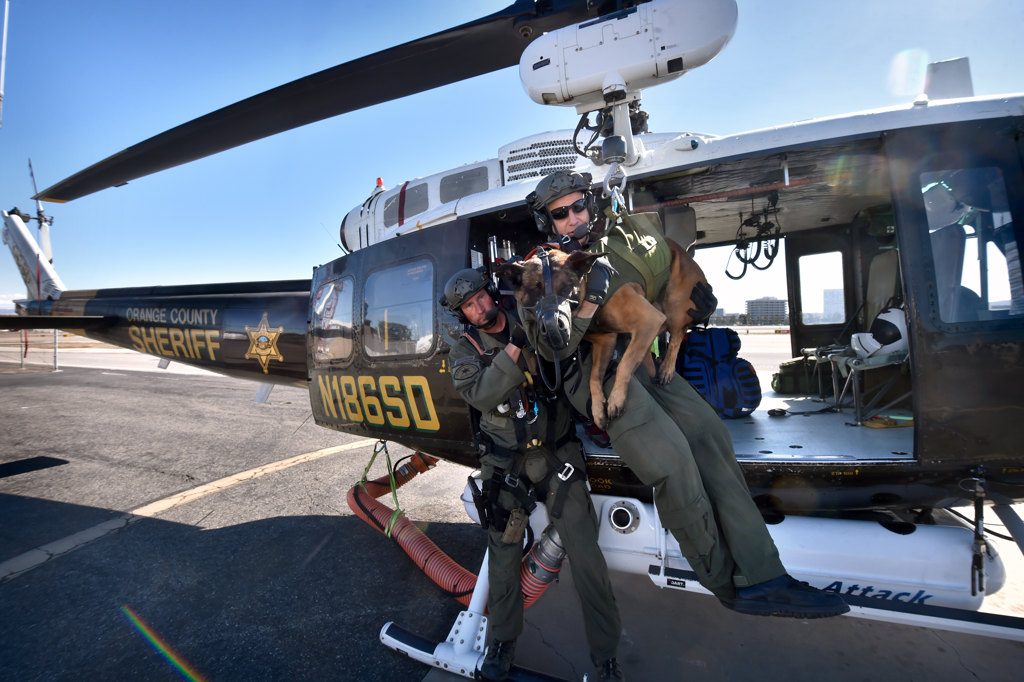
PSR (Professional Services Responder) Mike De Laby holds OCSD K9 Cento while being lifted into OCSD’s Duke 6 helicopter. On the left is Reserve Deputy and PSR Jim Slikker, a tactical flight medic.
Photo by Steven Georges/Behind the Badge OC
That was exactly what K9 Cento was exposed to on a recent Friday. Muzzled and harnessed, he was introduced to the hoisting technique a few feet off the ground while a medic held him.
Part of the process is for the medics to learn the dogs’ commands – in a foreign language – so they know how to communicate with them, with or without their handler. In an emergency situation, the handler might not be taken along with the dog. The medics must speak in soothing tones and maintain a calm demeanor so that the dog, in turn, remains calm, De Laby explained.
“Once they kind of understand what’s going on and you talk to them … they’re pretty comfortable,” he said.

PSR Mike De Laby holds OCSD K9 Cento while being lifted by a hoist into OCSD’s Duke 6 helicopter in a training exercise to prepare the K9 should he ever need to be rescued by a helicopter. Reserve Deputy and PSR Jim Slikker, a tactical flight medic, right, supports them as Cento’s handler, Deputy Mark Van De Kreeke, left, stays within sight of his K9.
Photo by Steven Georges/Behind the Badge OC
In addition to assisting any injured OCSD K9, the team also works with the Santa Ana Police Department and would assist their dogs, as well as any other agency, that requested their services.
“It’s a good program to make sure our K9 law enforcement family is taken care of,” said De Laby.
OCSD Deputy Mark Van de Kreeke, Cento’s handler, said: “It’s an awesome resource … it’s great knowing that we have that resource in case I get hurt, in case my dog gets hurt.
“It’s comforting for me. It’s comforting for all the K9 handlers out there.”
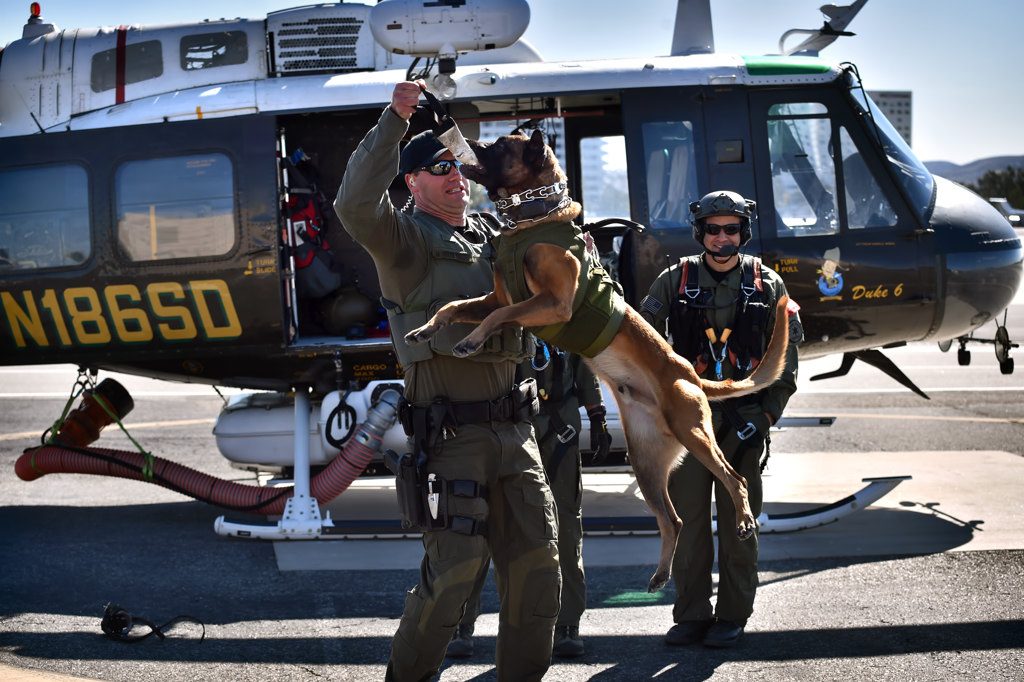
OCSD Deputy Mark Van de Kreeke gets his K9, Cento, used to the harness by lifting him off the ground in it.
Photo by Steven Georges/Behind the Badge OC
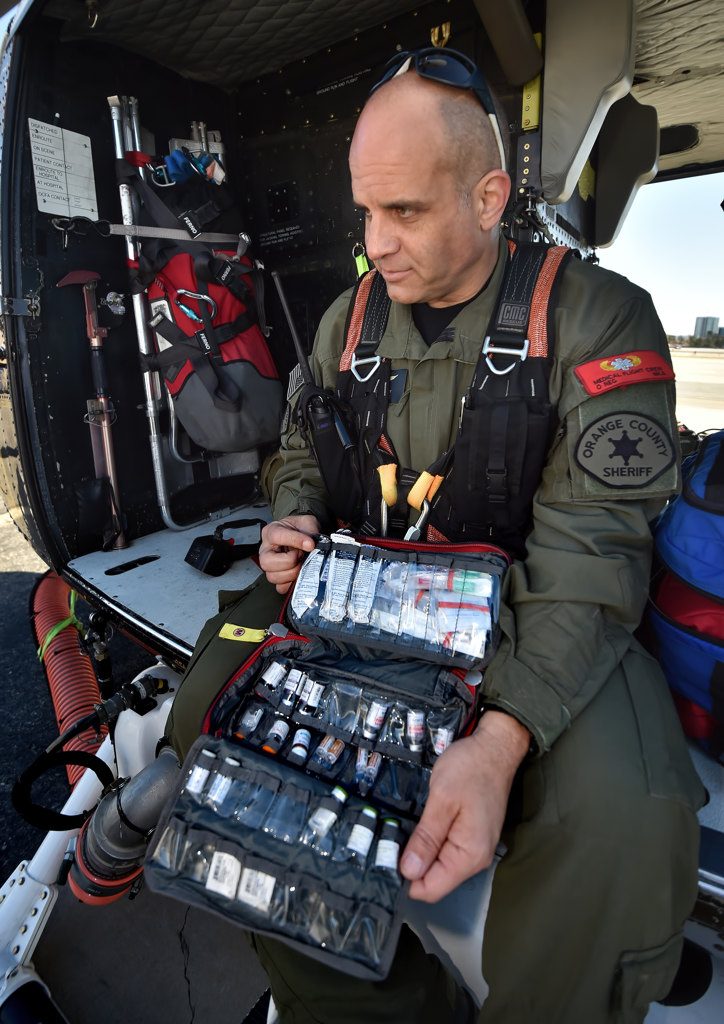
PSR Mike De Laby, Special Enforcement Bureau chief medic, shows one of the medical kits kept on board of OCSD’s Duke 6 search and rescue helicopter that can be used to treat injuries for both humans and K9s.
Photo by Steven Georges/Behind the Badge OC
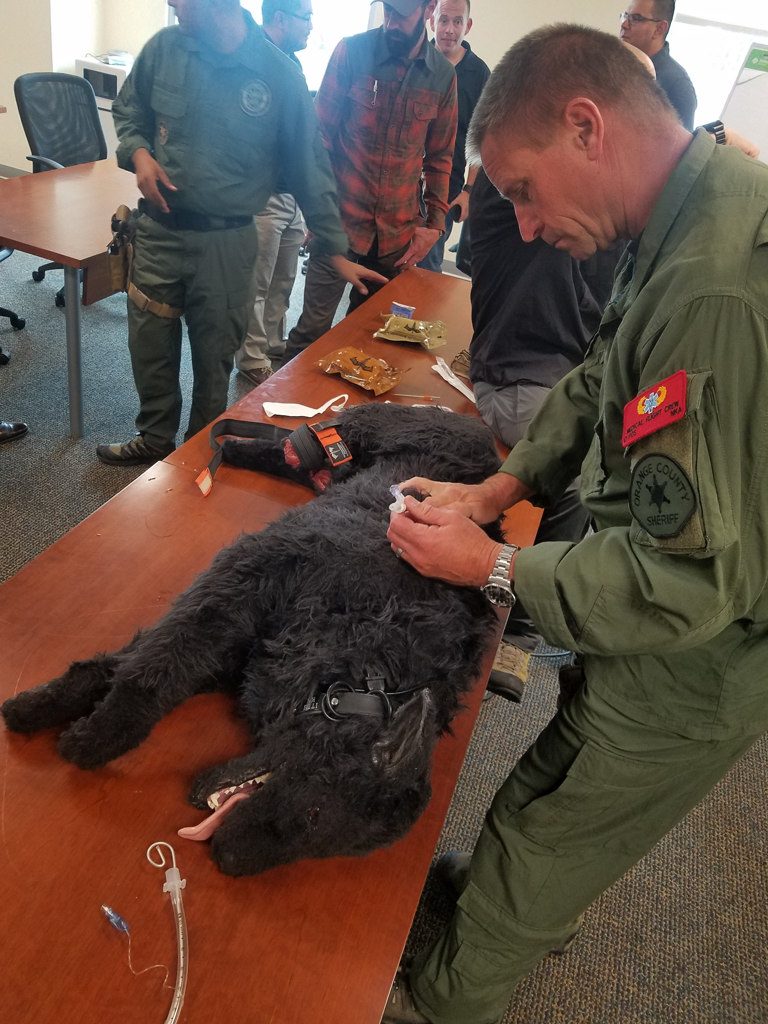
A mannequin of a K9 is used for training on procedures and interventions that would be used in the field. Photo courtesy of OCSD
Video of K9 training provided by Mike De Laby.
 Behind the Badge
Behind the Badge
